Shipley Park - Miller-Mundy
Memories
w/e 06 May 2007
All
this week's pictures were taken with a Kodak DX6490

Part 5 - Up Shipley Hill
In the previous four parts of this series looking at the influence
of the Miller-Mundy family on the area, we have been following
the Nutbrook Trail. Admittedly we have encountered a few minor
diversions to see the old railway station near the former Newcastle
Colliery site, the Woodside Colliery site and in Part 4, the
former haystack yard that is now the cricket ground. In this
fifth part however although we pick up the walk on the Nutbrook
Trail we shall leave it for good as we start to investigate more
about the family on Shipley Hill. We resume then near the entrance
to the cricket ground on the Trail at a point where it is also
Dog Kennel Lane.
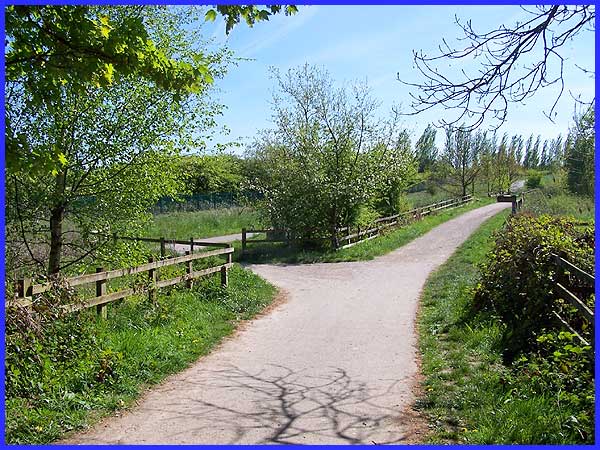
As we emerge from the trees to start the ascent of the hill,
Dog Kennel Lane continues straight ahead as a track whilst the
tarmaced path of the Nutbrook Trail chicanes to the left. Both
paths continue running almost parallel to each other for a hundred
yards or so before Dog Kennel Lane swings to the right and away
from the Nutbrook Trail to climb the steeper part of the hill
and become Lodge Walk. We have a choice here as to which route
to take and that decision could well be dependent on the underlying
ground conditions as we shall see later. On this occasion we
chose to continue along the Nutbrook Trail which also allows
a closer look at a sculpture behind the bush in the centre of
this image at the parting of the ways.
|
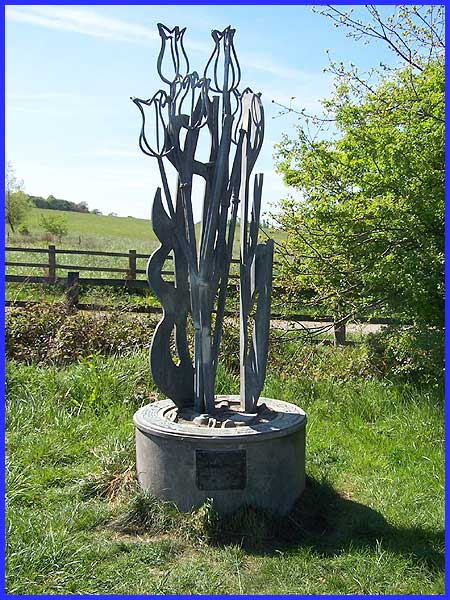
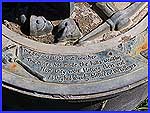 The sculpture
is one of three on the Nutbrook Trail celebrating the area's
heritage and its links with the author D. H. Lawrence. We
encountered another similar sculpture to this one in Part 5 of
the Hallam Fields Industrial Trail (link). The base of this sculpture is
inscribed with several quotations by Lawrence; the one pictured
left reads " One England blots out another. The mines made
the halls wealthy. Now they were The sculpture
is one of three on the Nutbrook Trail celebrating the area's
heritage and its links with the author D. H. Lawrence. We
encountered another similar sculpture to this one in Part 5 of
the Hallam Fields Industrial Trail (link). The base of this sculpture is
inscribed with several quotations by Lawrence; the one pictured
left reads " One England blots out another. The mines made
the halls wealthy. Now they were 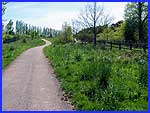 blotting them out as they had already blotted
out the cottages." Another reads "The industrial England
blots out the agricultural England. One meaning blots out another."
Since the closure of the mines, the landscape has more of an
agricultural look to it even though it has not fully returned
to the earlier landscape that Lawrence was referring to and hankering
for. It's strange how one's perspective changes with the passage
of time and if he were sill alive today, he would probably be
remembering the industrial past of the area with some nostalgia.
From here we continue up the steady incline (right) of Shipley
Hill. blotting them out as they had already blotted
out the cottages." Another reads "The industrial England
blots out the agricultural England. One meaning blots out another."
Since the closure of the mines, the landscape has more of an
agricultural look to it even though it has not fully returned
to the earlier landscape that Lawrence was referring to and hankering
for. It's strange how one's perspective changes with the passage
of time and if he were sill alive today, he would probably be
remembering the industrial past of the area with some nostalgia.
From here we continue up the steady incline (right) of Shipley
Hill.
|
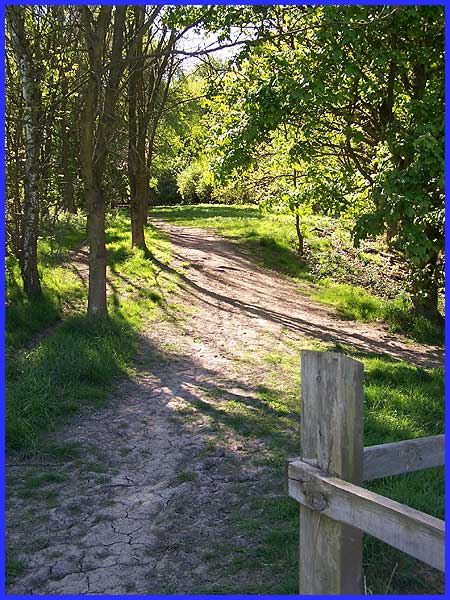
This really is the parting of the ways now as Dog Kennel Lane
swings away to the right. It is still possible to cross between
the two tracks but the recent dry weather evidenced by the cracked
earth, means that we can take the short but steep well worn path
up the hill. In wet weather this can be quite treacherous and
I would recommend the Dog Kennel Lane route as an alternative.
|

At the upper end of the path is the memorial stone recording
the opening of the Shipley Country Park by W. L. Milton of the
National Coal Board on May 26th 1976, just ten years after the
last coal was mined from the drift at Woodside No. 1. Coal extraction
from Woodside Nos. 2 and 3 shafts had ceased in 1961. It was
the Miller-Mundy family of course that was a pioneer of the coal
mining industry in the area. After climbing the hill we must
now turn right and pass the gate (shown bottom left above) and
along the track to reach Nottingham Lodge. Note: Following
the Dog Kennel Lane alternative would lead to Nottingham Lodge
first. This track is known as Coach Road and is another link
between Dog Kennel Lane and the Nutbrook Trail.
|
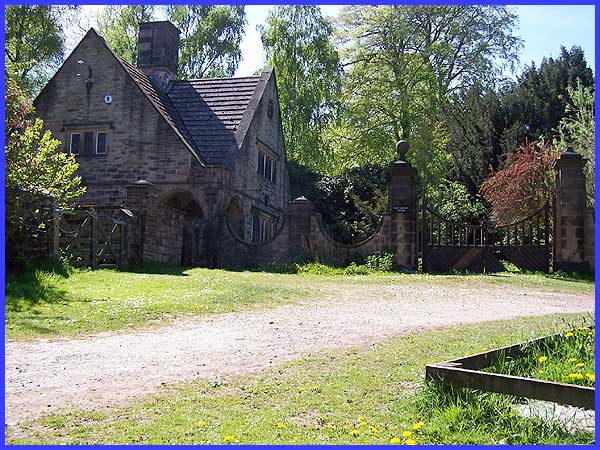
 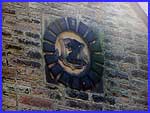 Nottingham
Lodge is one of a pair built in 1911, the other being Derby Lodge
which we will see later in this series. They were originally
called Ilkeston Lodge and Mapperley Lodge respectively. Records
from the fourteenth century show that Shipley was a sporting
estate with a lodge on the hill and the area was prized for its
extensive forest and excellent hunting. The family crest, the
Spotted Wolf, that we saw on the cricket pavilion is also prominent
here on the gable end of the lodge. Nottingham
Lodge is one of a pair built in 1911, the other being Derby Lodge
which we will see later in this series. They were originally
called Ilkeston Lodge and Mapperley Lodge respectively. Records
from the fourteenth century show that Shipley was a sporting
estate with a lodge on the hill and the area was prized for its
extensive forest and excellent hunting. The family crest, the
Spotted Wolf, that we saw on the cricket pavilion is also prominent
here on the gable end of the lodge.
|
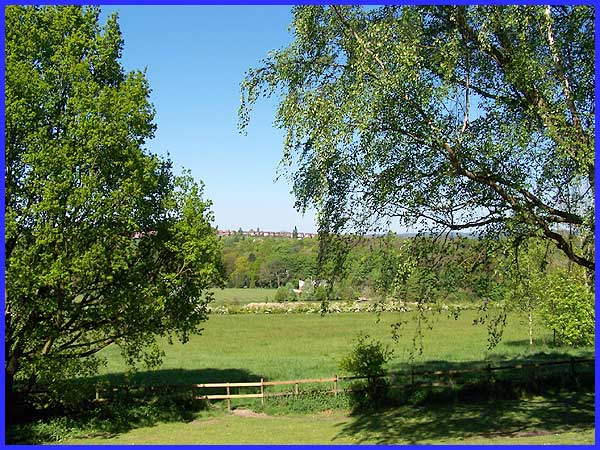
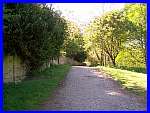 The two lodges are linked by Lodge
Walk which is lined by the Suffragette Wall, a stone wall built
to protect the estate from the suffrage movement. It is difficult
to imagine that the suffragettes would have posed so much of
a threat to the estate that a stone wall had to be built and
in all honesty, it is not that high and could easily be scaled.
But before we continue, this is a good place to pause, look down
the hill between the trees back to the cricket ground, take stock,
and try to imagine the scene when Sir Walter Tapper worked on
the estate, enlarging the Hall for the then owner, Alfred Edward
Miller-Mundy. I'm sure D. H. Lawrence could have written a very
intriguing story about those times. The two lodges are linked by Lodge
Walk which is lined by the Suffragette Wall, a stone wall built
to protect the estate from the suffrage movement. It is difficult
to imagine that the suffragettes would have posed so much of
a threat to the estate that a stone wall had to be built and
in all honesty, it is not that high and could easily be scaled.
But before we continue, this is a good place to pause, look down
the hill between the trees back to the cricket ground, take stock,
and try to imagine the scene when Sir Walter Tapper worked on
the estate, enlarging the Hall for the then owner, Alfred Edward
Miller-Mundy. I'm sure D. H. Lawrence could have written a very
intriguing story about those times.
Back to Part 4 - From Coal To Cricket
------ Forward to Part 6 - The
Rise and Fall of Shipley Hall
Use the Quick Links below to access other pages.
|